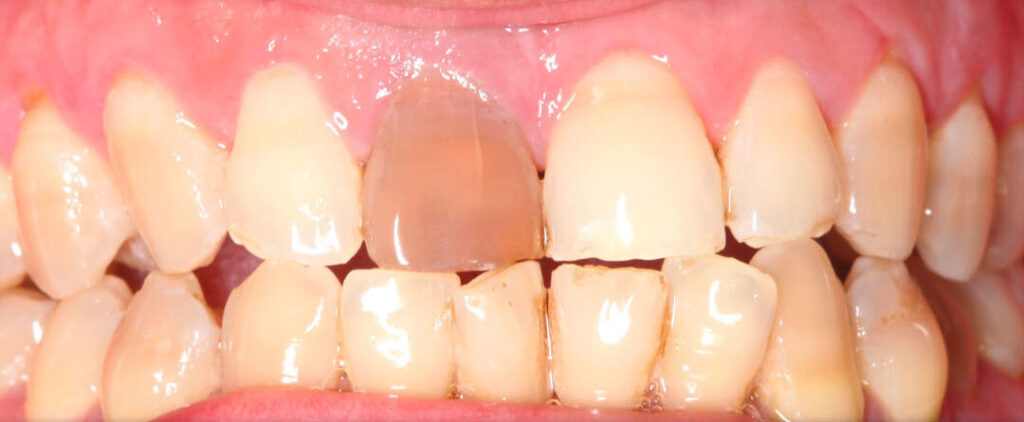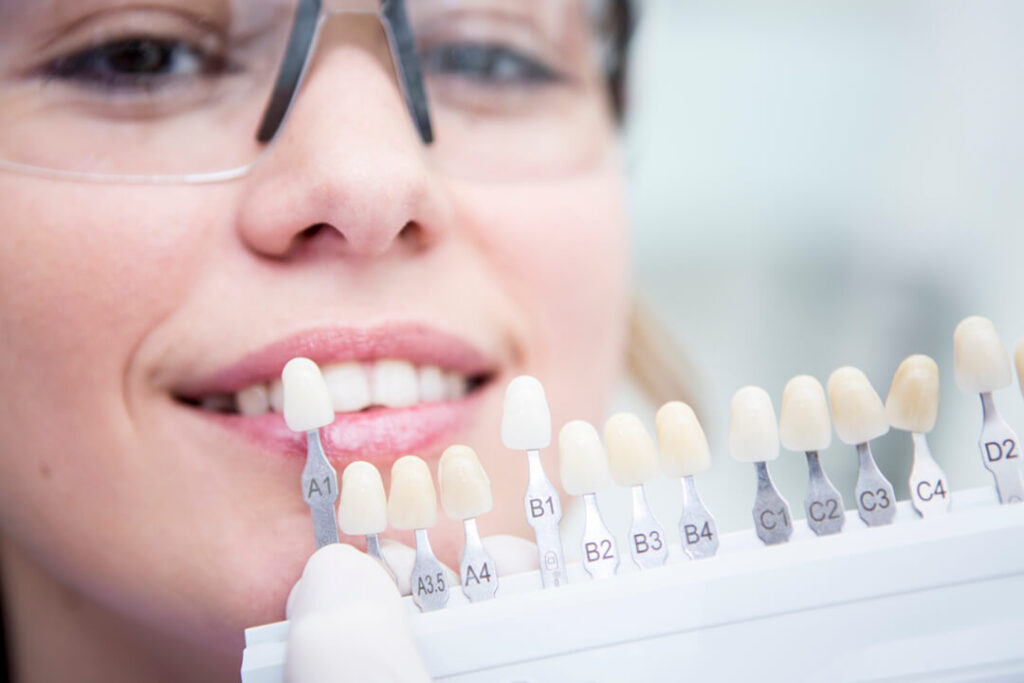Internal Tooth Bleaching
Internal Tooth Bleaching is a teeth whitening procedure done from the inside of the tooth. It is normally done on a tooth that has previously undergone endodontic treatment.
The main reason this happens is because a dead tooth loses its vitality and becomes dehydrated, causing it to turn black. A 2nd reason is tooth decay from caries.
In the first case, internal tooth bleaching is the only option. Basically, internal tooth bleaching is a procedure that targets discoloration from the inside out. This way you can make sure your teeth are white again!

The difference between internal and external Bleaching
External bleaching is the method most people are familiar with. The dentist can apply the whitening technique at home or in the dental office.
External bleaching, whitens the surface of the teeth. Usually, the procedure is applied to all teeth.
Internal tooth bleaching, on the other hand, targets a single tooth, or perhaps a few specific teeth, that have become discolored due to endodontic treatment or trauma. During the internal whitening procedure, the tooth is whitened from the inside. It is a more invasive procedure, compared to external teeth whitening.

How Internal Tooth Bleaching works
If you are not satisfied with the appearance of your tooth after endodontic treatment or trauma, when it comes to its color, talk to your dentist.
To begin, an examination will be performed and an X-ray may be needed to get a clear picture of the tooth of interest and whether Internal tooth bleaching is indeed your best option.
Sometimes the source of the discoloration is the decay of the tooth with caries, in which case a dental filling is usually required.
If internal tooth bleaching is right for you, your dentist will make a tiny hole in the back of the discolored tooth. Next, a whitening material will be placed inside the upper part of the tooth (that is, where the tooth is visible from the outside). The whitening material stays on the tooth for as little as 30 minutes or as long as several days, depending on the severity of the discoloration. The dentist then removes the whitening material and reseals your tooth.
Internal tooth bleaching is a low-risk procedure, although some patients may experience some increased sensitivity which passes. As always, discuss any concerns you may have with your dentist.
Most people like the way their tooth looks after internal tooth bleaching, especially if they felt bad about their tooth discoloration before.
Being able to laugh, eat, sing and smile without shame is such a joy. But in the end the choice is yours!
We believe in empowering our patients to live a life of wellness and balance.

Advantages and Disadvantages of Internal Tooth Bleaching
Like any procedure internal tooth bleaching has advantages and disadvantages that may make it suitable for some patients and conditions, but not for others.
1. It is a safe and effective way to whiten even a dead tooth.
2. The procedure is simple and quite cheap compared to some other aesthetic treatments.
3. Does not require anesthesia.
4. Internal tooth bleaching preserves more of the natural tooth structure, unlike Tooth Veneers, so it doesn’t further weaken the tooth.
5. It can help you feel more confident about your smile.
1. Depending on the severity of the discoloration, several treatment sessions may be needed to achieve the desired level of whiteness.
2. The tooth of interest may not match your other teeth exactly. Often, at first it is slightly whiter than the surrounding teeth. After some time, however, the color of the tooth comes into balance with the rest. Of course, this can be avoided if external whitening is also done.
3. Results sometimes last about 5-6 years before a difference in color is noticeable, so maintaining your teeth white may require follow-up treatments about every 1.5 to 2 years.
If you are considering Internal tooth bleaching, have an honest discussion with your dentist. Understanding your options and making informed decisions is important when it comes to your health. Ask what you can expect based on your Dentist’s professional experience.

Maintaining the results of internal tooth bleaching
Since internal tooth bleaching usually lasts about 5-6 years, you may need follow-up sessions to maintain the results. Talk to your Dentist about this so you can make an informed decision and plan for the future.
Additionally, talk to your Dentist about what you can do to keep your mouth healthy to minimize the chance of future dental fillings or endodontic treatment.
Here are some steps you can take to maintain the whitening effect:
- Brush your teeth twice a day with a very soft toothbrush and fluoride toothpaste.
- Clean your teeth daily with dental floss.
- Consider wearing a night splint if you grind your teeth.
- If you play contact sports, consider wearing a mouth guard to protect your teeth from collisions.
- Visit your dentist for an examination and dental cleaning. Depending on your history and oral health, when you will need a cleaning and checkup will also vary.
- If your dentist has different advice for you that is specifically for you, always follow that advice.
- Discuss any pain, discomfort or questions you have with your dentist.





